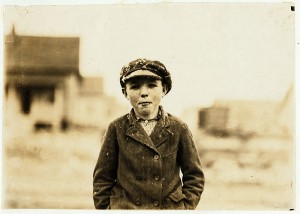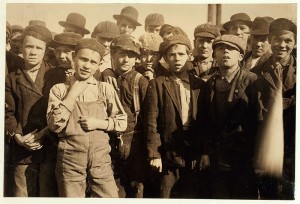When Irish Children Were the “Criminals”…

Joseph Hoffman, 13, was sent to the House of Refuge for hitting his mother on the head with a shovel (image by Lewis Hine, 1895)
As new immigrants to New York City, the Irish were perceived to be “threats to the social order.” Their children were considered unruly and therefore came to the attention of authorities and reformers. The purpose of reformers in establishing the nation’s first juvenile reformatory (the New York House of Refuge) in 1825 was to exert social control over populations considered to be in need of supervision and assimilation. Ironically, it was Irish children’s white skin that helped to criminalize them in the early to mid-19th century.“By 1840, Irish children constituted half of the Refuge’s inmates. Between 1850 and 1855, their commitment rates soared to 63%; despite the fact that Irish immigration to the United States was on the decline (p.112).”
Black children fell outside of the concern of early juvenile justice reformers in cities like New York. It wasn’t in fact until 1850 that the first House of Refuge opened in Philadelphia specifically for “colored” children. In New York, black children were a minority. Additionally, there is some evidence that black children were less likely to get into trouble with the law. Christopher M. Span (2002) sheds light on this reality:
“Persons interested in the reformation of children accused and found guilty of crime argued that the primary reason African American children in New York City rarely got into trouble with the law was because they had employment, no matter how menial (p.112-113).”
Yet there is much that we still don’t know about how juvenile justice applied to black youth in the 19th century. Even though it appears that black children were not heavily targeted as committing crimes in cities like New York in the early to mid-19th century, there are many outstanding questions as to why this was. If they were not disproportionately incarcerated in juvenile reformatories until the late 19th century perhaps they could be found in larger numbers in adult jails and prisons? Available research suggests that this may not have been the case.
Most black children in the United States before the Civil War were born slaves so therefore they would not be present in large numbers in “free” states. Yet even when they did form a significant minority in urban centers, it appears that they were less likely to come to the attention of authorities and reformers. This could possibly be attributed to the fact that reformers were most concerned about the moral character of white children and therefore it was more urgent to “reform” them so that they could take their rightful place as good citizens and future “white” leaders of the nation. Interestingly then, black children in some cities escaped the criminalization which would become more prevalent in the late 19th century. I am embarking on a major research project next year about the historical criminalization of black youth so stay tuned as I will hopefully have much more to share on this topic then.
For those who are interested in learning more about Houses of Refuge in the 19th century, I wrote about them here last year.

